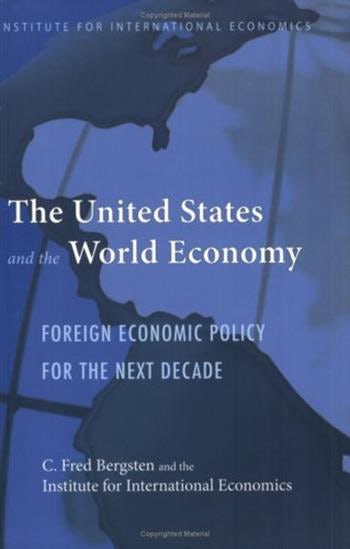What are the key foreign economic policy issues facing the United States in the second half of this decade? How can the administration and Congress meet the economic challenges that lie ahead? This new book analyzes the dramatic importance of the world economy to both the domestic prosperity and overall foreign policy of the United States, describes the new global environment (e.g., the rise of China as a global economic superpower and the completion of European unification) in which US policy must operate, and proposes major US initiatives on a wide range of international economic issues, including correction of the huge current account deficit, new trade negotiations, and energy. Individual chapters by senior staff of the Institute on each of the key topics are included.
- Cover
- Contents
- Preface
- Executive Summary
- I Foreign Economic Policy for the United States
- Chapter 1 A New Foreign Economic Policy for the United States
- Short-Run Agenda
- Domestic Foundations of Foreign Economic Policy
- The New Global Context
- Proposals for Policy
- US Foreign Economic Diplomacy
- Conclusions
- II The Policy Context
- Chapter 2 The Payoff to America from Global Integration
- The Payoff from Past Liberalization
- The Payoff from Future Liberalization
- Conclusion
- Appendix 2A Intermediate Imports: Gains Through Worker Productivity
- Appendix 2B An Estimate of Labor Adjustment Costs
- Chapter 3 Uneven Gains and Unbalanced Burdens? Three Decades of American Globalization
- Uneven Gains?
- Unbalanced Burdens?
- Quo Vadis American Policy?
- Chapter 4 China The Great New Economic Challenge?
- China’s Emergence in the Global Economy
- US–China Economic Relations
- Causes of the Bilateral Trade Imbalance
- China as a Technological Leapfrog
- China’s Exchange Rate
- Implications for US Policy
- Chapter 5 The United States and the Large Emerging-Market Economies: Competitors or Partners?
- Summary of Recommendations
- Who Are the LEMs?
- Why Are the LEMs Important to the United States and the World
- How Should the United States Deal with the LEMs?
- Active Collaboration Between the United States and LEMs
- Budgetary Reality Check
- III The Key Issues
- Chapter 6 Sustaining Global Growth while Reducing External Imbalances
- Forces Behind the Recent Rise of the US External Deficit
- Emergence of the “Twin Deficits” During the 1980s
- Factors Behind the Strong Dollar of the Late 1990s
- Recent Developments and Future Prospects
- Sustainable Scale of External Imbalances
- General Need for Exchange Rate Adjustment
- Industrial-Country Policies to Contribute to Orderly Reduction of External Imbalances
- Key Issues for Developing Countries in the Orderly Reduction of International Imbalances
- Conclusion: Virtues of Some International Policy Cooperation
- Chapter 7 Energy: A Gathering Storm?
- Sources of Strain in Global Energy Markets
- Strains on the Oil Market: Repeating History
- Scenarios for World Oil Markets and the World Economy
- Economic Impacts of the Next Price Shock
- Moderating or Avoiding the Impending Energy Crisis
- Short-Term Measures to Address the Current Problem
- Long-Term Strategies for Addressing the Energy Problem
- Conclusion: Time Is Short and Action Is Required
- Appendix 7A The BP Prudhoe Bay Trust's Link to WTI
- Chapter 8 Confronting Current Challenges to US Trade Policy
- Domestic Trade Policy Agenda
- International Trade Agenda
- Conclusions
- Chapter 9 Offshore Outsourcing and the Globalization of US Services: Why Now, How Important, and What Policy Implications
- Globalization of Services: How New? How Different?
- How Important Is Globalization of Services for the United States?
- Globalization of Services and Jobs: The Numbers for the United States
- Globalization of IT and US Performance
- Globalization of Services: Is There No End to It?
- Responding to Global Sourcing: Maximizing Gains and Moderating the Backlash
- Final Words
- Chapter 10 Easing the Adjustment Burden on US Workers
- Trade Adjustment Assistance
- Unfinished Business
- A More Ambitious Agenda
- Recent Congressional Activity
- MFA Removal
- Legislative Opportunities
- Summary and Conclusion
- Appendix 10A Highly Import-Competing Industries, 1979-2001
- Chapter 11 Challenges for US Immigration Policy
- Past and Current US Immigration Policy
- Profile of US Immigration
- Benefits and Costs of Immigration
- Reforming US Immigration Policy
- Chapter 12 The International Financial Architecture
- Discouraging “Beggar Thy Neighbor” Exchange Rate Policies
- Controlling Currency Mismatches in Emerging Economies
- Debt Sustainability
- International Standards and Codes
- Early Warning Systems
- IMF Lending Policies
- Concluding Remarks
- Chapter 13 Fostering Development
- Trade
- Development Assistance
- Concluding Remarks
- About the Contributors
- Index

